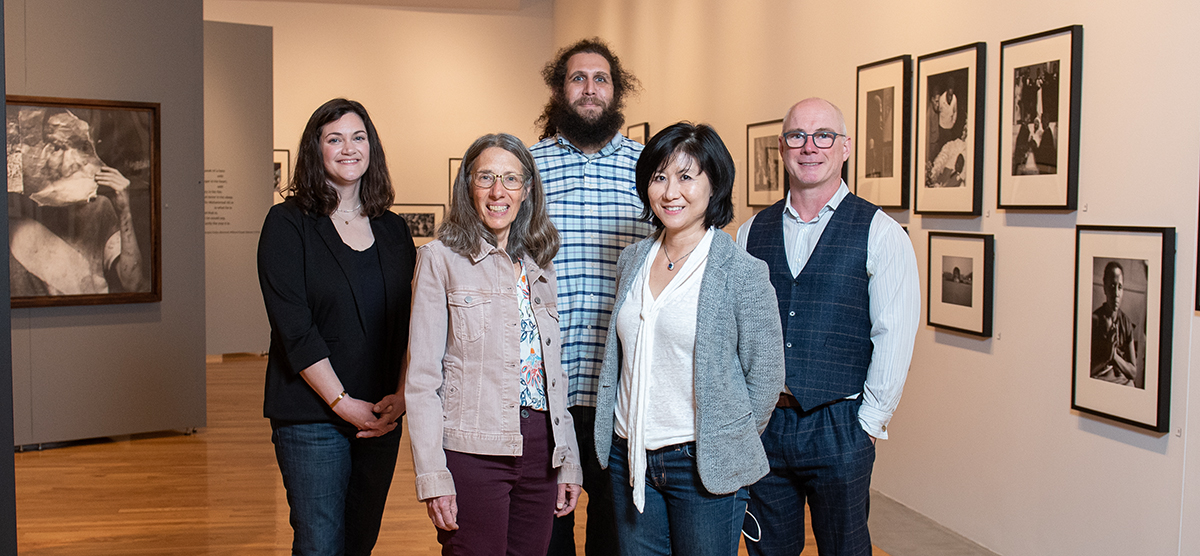A passion for Parks
Team digitizes Gordon Parks’ work
By Taylor Provine

Above: Members of the Gordon Parks project team stand at the “Gordon Parks: Homeward to the Prairie I Come,” exhibition at the Beach Museum of Art. The team includes, from left, Sarah Price, collections manager; Katherine Karlin and Cameron LeaderPicone, both associate professors of English; Aileen June Wang, curator; and Mark Crosby, associate professor of English.
Seek more
View the virtual exhibition of "Gordon Parks: Homeward to the Prairie I Come" at the Marianna Kistler Beach Museum of Art.
Learn more about events and programming related to the exhibition.
The iconic Gordon Parks was more than a prominent photographer: He was also a writer, filmmaker and musician. Several Kansas State University researchers are highlighting some of his multimedia material in a digital archive.
Katherine Karlin and Cameron Leader-Picone, both associate professors of English, and Aileen June Wang, curator at the Marianna Kistler Beach Museum of Art, are leading the Gordon Parks project. Their team includes other College of Arts and Sciences faculty in the A.Q. Miller School of Journalism and Mass Communications and English department as well as staff at the Beach Museum of Art.
In 1969, Parks was the first African American to direct a Hollywood feature film based on his semiautobiographical novel, “The Learning Tree.” The K-State project examines the movie — filmed in his hometown of Fort Scott, Kansas — and several of its related documents that are housed in the K-State Richard L. D. and Marjorie J. Morse Department of Special Collections.
“It’s interesting in many ways,” Karlin said. “It’s a rare example of a movie that a director adapted from a novel that he wrote himself, it was made in Kansas, and it chronicles Black life in Kansas in the 1920s, which has not been chronicled much on film or in literature.”
The researchers received a National Endowment for the Humanities grant to support the planning of the project and are working with the Gordon Foundation to publish the content, which includes photographs of the movie shoot, memorabilia and interviews, on a website
“This is a way to highlight his writing in connection with his photography and to look at the ways in which his work existed across mediums and across forms,” Leader-Picone said. “But more than that, I think there’s a broader significance to thinking about Parks, not just as singular figure, but as a representative of a tradition of creative work coming out of the Black Midwest, particularly in areas in which we tend not to think about the Black experience.”
In 1973, Parks donated 128 of his photographs to the university. The K-State project also includes in-person and virtual exhibitions of the photographs, titled “Gordon Parks: Homeward to the Prairie I Come,” at the Beach Museum of Art. The exhibition co-curators include Wang and Sarah Price, collections manager.
Wang is editing an exhibition catalog that includes research and essays about Parks by all project team members. It will be published by K-State’s New Prairie Press as an open-access e-book.
“In the catalog, I argue that Parks saw his gift to K-State as an opportunity to create a self-portrait of sorts and think about what he wanted to say to his fellow Kansans,” Wang said.
The exhibition will be on display through May 28, 2022.
Seek more
The following researchers have been involved in the Gordon Parks project:
- Mark Crosby, associate professor of English.
- Katherine Karlin, associate professor of English.
- Cameron Leader-Picone, associate professor of English.
- Sarah Price, collections manager, Marianna Kistler Beach Museum of Art.
- Aileen June Wang, curator, Marianna Kistler Beach Museum of Art.
- Student interns/researchers: Kenan Dannenberg, Haley Claxton, Sean Kiernan, Daniel Dissmore, Marissa Pilolli, Jalen Thompson.